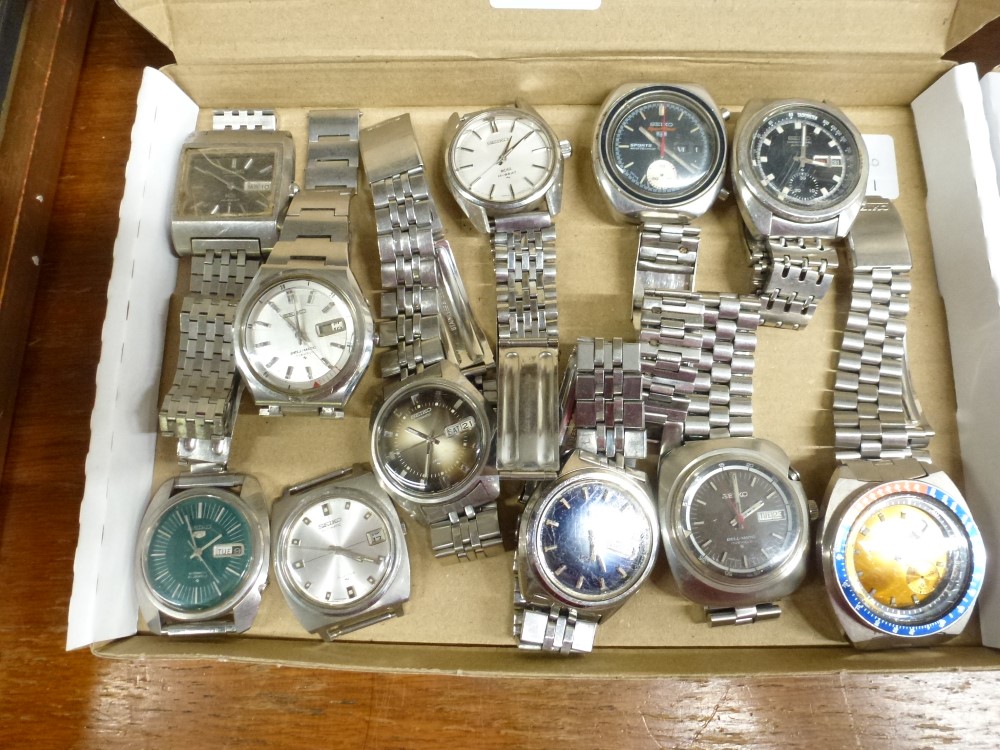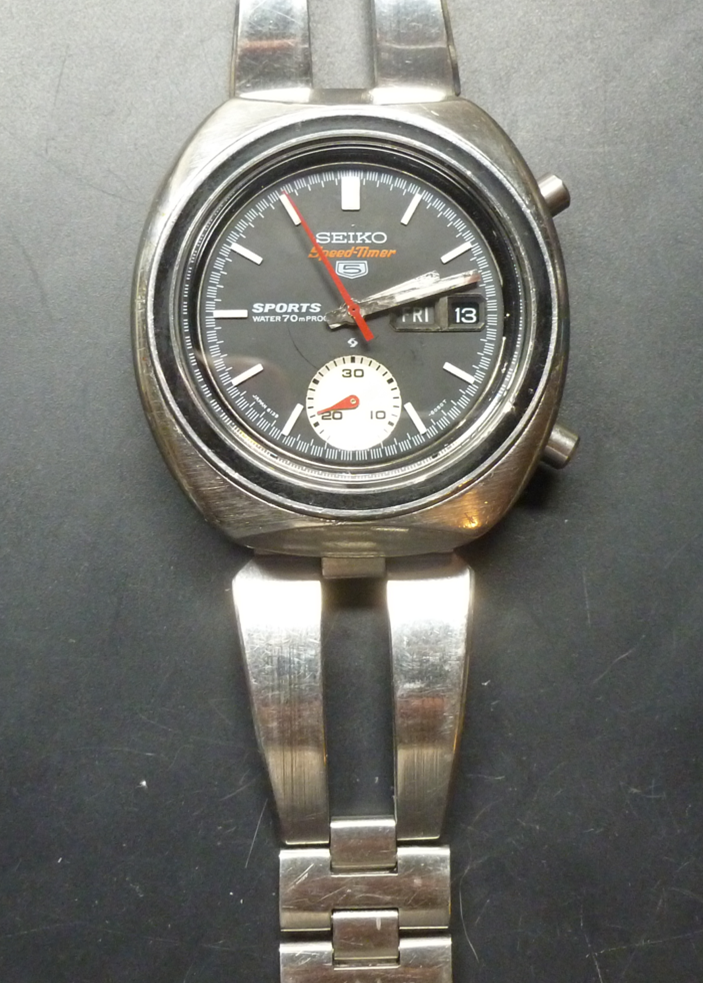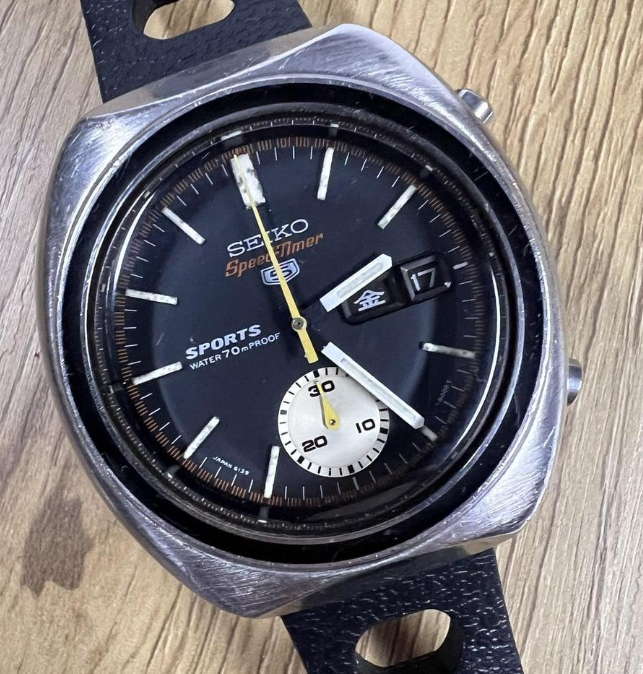So called “Frankenwatches” (see previous) are all over the place and tend to fall into several categories, depending on the base watch and the value associated with it:
Out and out fakes of the real thing
For example, putting in a replica “Paul Newman” dial into a real Rolex Daytona in order to boost its value, or installing an orange Chrono hand into a suitable Speedmaster mule and calling it an Ultraman. Some of the fake parts out there are really good, and if someone goes to the lengths of putting them into an otherwise legit watch, they’re only after falsely increasing the value. Avoid at all costs.
Watches with “service” parts
It is not uncommon for watches having various bits replaced when they go for a service – at least these days, if you return your special watch to its original manufacturer, they’re likely to send you back any bits they take off it and replace for new pieces. Watch companies historically thought – maybe because that’s what the public expected, especially when they were spending lots of ££ – that when a piece came in for service, it should go back to the user as new-looking as possible. Tut, tut, that bezel has a few scratches on it, let’s replace it (for a fee) with a brand new one. Or look at that unsightly yellow tritium lume on the dial, let’s just swap the whole thing with a nice new Superluminova one. A good way of ruining your vintage watch’s value was to send it back to Bienne or Biel for a service. These don’t count as Frankens, more just unfortunate cases of over-restoration.
At the lower end of the market, it’s quite possible if a watch went into a high-street jeweller in the 1980s, it could have been fixed up with whatever parts were lying around, even at the wearer’s request. Bracelets would be discarded as they were stretching and worn, in favour of off-the-shelf Fix-O-Flex type junk that the jeweller had on their counter. It’s also possible that bits would have been replaced unexpectedly – accidentally installing the wrong case back on the watch, or fitting a replacement subdial hand because an existing one was working loose – and the “watchmaker” of the 1980s might have just gone into his drawer for one that would fit, rather than replacing with the “correct” part.
So this category of franken can be a mix of 3rd party parts installed with good faith on an old watch, or maybe an incorrect mixture of bits pulled together so the wearer could get it back on their wrist every day, like they had for the last decade.
Tarted up low-value watches
This is the category we see more often with lower value stuff that’s to be found on eBay and the likes. Take a watch that looks a bit beaten up, swap out the dial, hands, bracelet, give it a “service” and fire it on eBay saying how shiny and lovely it is, with a little caveat that “due to its age, some parts may have been replaced”. Often combined with other dodgy sales tactics (like “shill bidding”), there are many which have been deliberately tarted up with undisclosed aftermarket parts. While they might look the part, an unsuspecting buyer could pay market rate for a real thing, maybe without realising that they’re probably buying a pup.
All of which blather leads us to this specimen.
It was acquired a few years back in an auction, unseen until after the hammer had fallen. Part of a job lot of busted up watches, it was a foolish brave buy, but some of the others became donors for parts to other watches, or made their way onto eBay with appropriate descriptions and decent photographs. The lot …

Most of them didn’t work, really. The keystone to the whole lot must have been the yellow Pogue on the bottom right – a keen passing eye could see it’s got a Stelux President bracelet (goood…) and with a black chapter ring, it maks itself out as an “Aussie”, which is also pretty good. The picture shows that there’s clearly something wrong with it, as the dial / movement is rotated and not fixed properly, and at least the subdial hand is missing. After swapping the black chapter ring for a less nice one, and taking the bracelet off, it made a couple of hundred £ on eBay, but given the whole lot cost over £1K in hand, it’s a matter of minimizing losses to some degree. The same was true of the black “Bruce Lee” on the top right – missing not just a subdial hand but various parts of the moment, so ostensibly not worth a lot, but I took the bracelet off and it returned £150 or so.
I quite liked the look of the watch next to the Bruce Lee, though and when all is said and done, it cost less than £100. It was running though the subdial hand had fallen off (but at least was still in the case).
What the photo doesn’t show is that it came on a “Razor” bracelet, a genuine Seiko item and quite unusual, though I wasn’t sure was original. Off the watch went to be serviced, and it needed quite a lot of work (about £300) but I decided to go ahead as it’s quite literally a pièce unique…
On closer inspection, this thing is a franken, probably cobbled together from available (genuine) Seiko bits just to make a working watch, and somehow, I rather like it.
Here’s what I think it actually is. First off, it says on the case back that it’s a 6139-8002, which should look like this:
… whereas my watch in question looks like…
Dial: Though ostensibly quite similar to the –8002 dial, this one looks like a late 1970 “Coke” JDM Speed-Timer dial (ie from a 6139-6031). I had it relumed it to brighten it up a bit. The stamped code on the back of the dial is “00” (Seiko put a 2 digit stamp on the back of dials at the date of their manufacture, so normally it’s the same two digits as the watch serial number, or possibly one or two months adrift). Since the dial dates to Oct 1970, its original watch would likely have a serial number starting 09, 00, 0N or so. Maybe 08 or 0D.
Hands: maybe from a 6139-6002, probably blue (given the shade of blood red). Certainly not correct for either a 6139-6031 or 6139-8002.
Movement: Inside it has 6139B so could well have originated from October 1970 or so, and the fact that it is a 21-jewel variant of that movement demonstrates that it was a Japanese watch. It’s possibly that the moment and the dial belong together, though it’s possible to find other November or December dated JDM watches which still had the 6139A movement. In other series, you’d expect anything that said PROOF on the dial to be still carrying the 6139A, but that might not have always been the case, especially concerning the JDM-only watches. Another outlier, though; if it’s a JDM watch, what’s it doing with an English/Roman day wheel? That should be English/Kanji for any Japanese market watch.
Case/Back: Looks like a genuine Oct 1971 6139-8002 case and case back. If the case belongs to the case back (ie that hasn’t been switched), it wouldn’t have had this movement or dial inside.
Bracelet: Initially, I though it was likely a replacement from another Seiko, but there are plenty of examples of other 6139-8002s out there with the Razor (“Klingon”) bracelet. So maybe that is true.
Conclusion
I think this watch is an amalgam of 3 others; it was a real 6139-8002 case, caseback and bracelet. Inside it has a genuine 6139-6031 JDM dial and movement, but the hands were replaced with those from a blue 6139-600x.
Finally, by way of comparison, here’s a August 1970 “Coke” 6139-6031; sometimes called the Coke Pogue, it has the same case as the 6139-600x, but instead of red/blue (“Pepsi”) bezel, it has a red/black (“Coke”) one. Note also that it has a chapter ring/inner bezel, unlike the 6139-8002.
Q.E.D.?
Warning: Undefined variable $post in /var/www/wordpress/wp-content/themes/newsup/inc/ansar/hooks/hook-index-main.php on line 117


![img_20221109_220106-jpg[1] img_20221109_220106-jpg[1]](https://www.vintagewatchadvisors.com/wp-content/uploads/2024/01/img_20221109_220106-jpg1_thumb.png)
![20180127_152841-jpg[1] 20180127_152841-jpg[1]](https://www.vintagewatchadvisors.com/wp-content/uploads/2024/01/20180127_152841-jpg1_thumb.png)